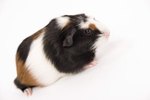
Hedgehogs (family Erinaceidae) are distinctive critters that are memorable for the many spikes that cover their somewhat rotund physiques. These spikes are called quills. Baby hedgehogs begin their lives with quills, albeit ones that aren't yet fully developed. Some adult hedgehogs are equipped with upward of 8,000 of the spikes.
Spikes at Birth
When hedgehogs are born, they already have small spikes. The spikes are markedly different than those of mature specimens, however. While adult hedgehogs' quills are prickly and hard in texture, babies' quills are somewhat pliable and smooth in feel. They're situated just below the skin at birth. When they're born, they're concealed under soft skin that is packed with liquid. This skin layer is crucial, as it prevents the quills from harming the mother as she bears her youngsters.
Appearance of the Spikes
Although newborn hedgehogs' spikes are initially below the surface, they don't stay hidden for long. The quills generally appear mere hours after birth. When this happens, the skin layer contracts, which enables roughly 150 of the spikes to make their debut. These young spikes are white. The quills of adult hedgehogs are often white or a combination of blackish and white.
Newborn Hedgehog Details
Birthing in female hedgehogs generally occurs no more than twice annually. The mothers typically produce litters that consist of between four and seven babies. Baby hedgehogs are referred to both as "piglets" and "hoglets." Brand new piglets have a rotund white appearance. They are unable to see. Once the little ones reach approximately a month in age, their quills are much more realized in appearance and texture. The quills are usually sturdy at this point, and they're often much deeper in coloration, as well.
Why Hedgehogs Have Spikes
The spikes on hedgehogs' backs are extremely valuable to their well-being and safety in the wild. The prickly things don't exactly feel too wonderful to touch, and as a result often keep worrying predators at bay. When hedgehogs face danger, they let their spikes stand up. This makes their bodies thorny. After they stand their spikes up, they position their bodies into tight and compact balls. This shields their vulnerable stomachs from possible attack. When hedgehogs are in ball form, not only do they feel disagreeable to the touch, they also are difficult to access.
References
Photo Credits
-
John Foxx/Stockbyte/Getty Images




